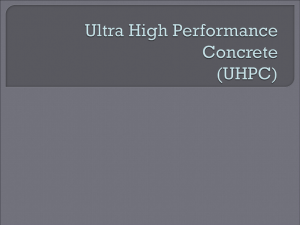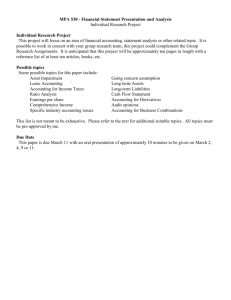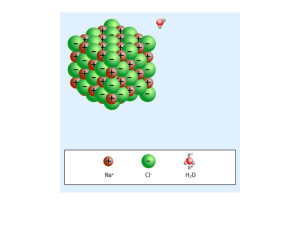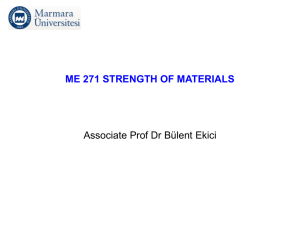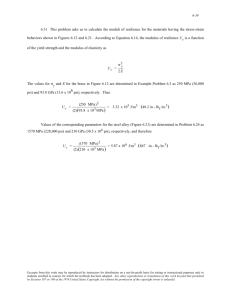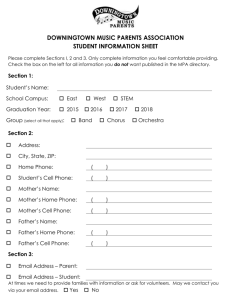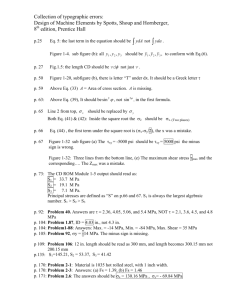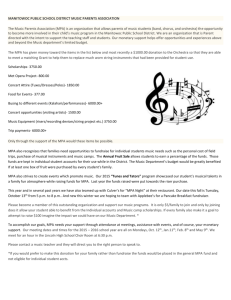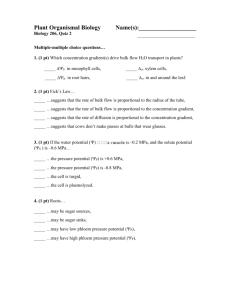- University of Portsmouth
advertisement
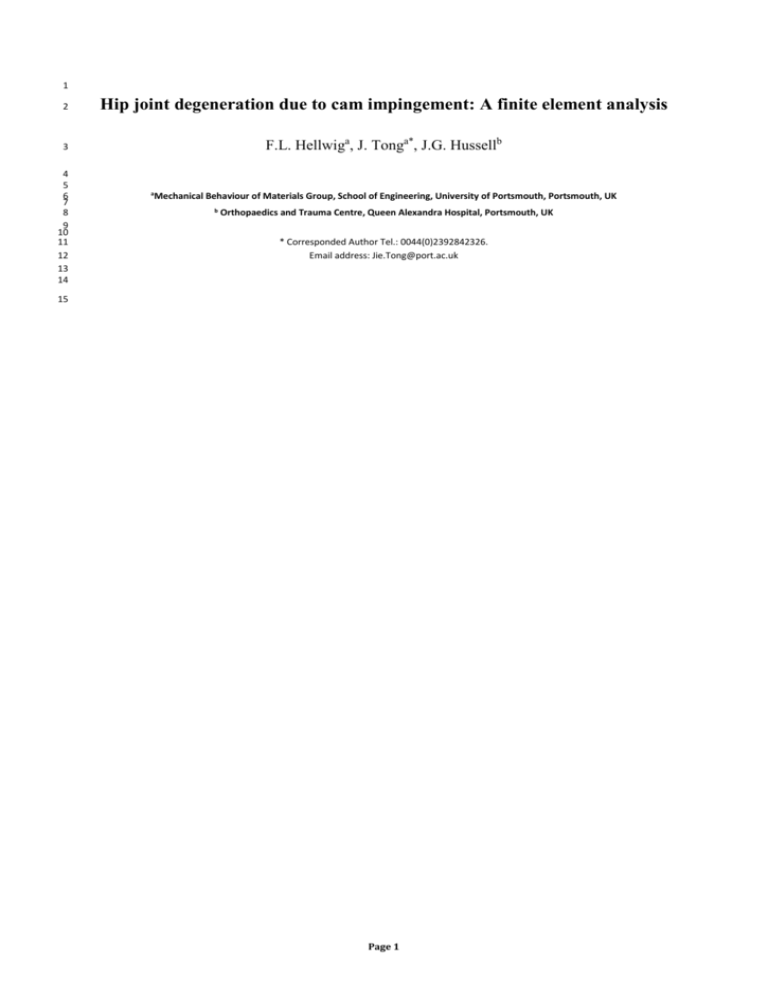
1 2 Hip joint degeneration due to cam impingement: A finite element analysis 3 F.L. Hellwiga, J. Tonga*, J.G. Hussellb 4 5 6 7 8 9 10 11 12 13 14 aMechanical Behaviour of Materials Group, School of Engineering, University of Portsmouth, Portsmouth, UK b Orthopaedics and Trauma Centre, Queen Alexandra Hospital, Portsmouth, UK * Corresponded Author Tel.: 0044(0)2392842326. Email address: Jie.Tong@port.ac.uk 15 Page 1 16 Hip joint degeneration due to cam impingement: A finite element analysis 17 The goal of this study was to investigate the impact of cam impingement, a 18 biomechanical risk factor, on hip joint degeneration and ultimately coxathrosis. 19 3D finite element solid models of a healthy and a pathologic hip were developed 20 based on clinical reports. The biphasic characteristics of cartilaginous tissues 21 were considered to identify localised solid matrix overloading during normal 22 walking and sitting down. Localised femoral intrusion at the anterior-superior 23 pelvic horn was revealed in the pathologic hip during sitting down, where the 24 radial 25 circumferential solid-stresses within the acetabular labrum increased by 3.7, 1.5 26 and 2.7 times, respectively. The increased solid-on-solid stresses, reduction in 27 fluid-load support and associated higher friction during articulation may result in 28 joint wear and other degenerative changes in the hip. 29 Keywords: Hip Joint, Cartilage Degeneration, Biphasic Model, Contact 30 Pressure, Finite Element, Impingement and meridional solid-stresses 31 Page 2 in the acetabular cartilage and 32 Introduction 33 Excessive contact stresses in the hip joint due to obesity (Rečnik et al. 2009) or decreased 34 weight bearing area typical in a dysplastic hip (Mavčič et al. 2002; Russell et al. 2006) are 35 thought to result in coxathrosis. Recent clinical studies hypnotised a link between abnormal 36 anatomical conditions of femoral head-neck junction and early degenerative changes of the 37 hip joint, such as osteochondral defects and labral tear leading ultimately to idiopathic 38 osteoarthritis (Ito et al. 2001). The pathologic condition, named cam type femoroacetabular 39 impingement, is caused by jamming of a non spherical extension of the femoral head into the 40 acetabular cavity (Ganz et al. 2003, 2008). Nötzli et al. (2002) characterised this anatomic 41 abnormality by introducing an alpha angle (Figure 1). This angle is measured between the 42 femoral neck axis and a line extended from the point C, the femoral head centre, to point D, 43 which is the point of deviation from femoral head sphericity. The abnormality might emerge 44 as an anterior bump, spigot or thickened femoral neck, limiting the range of motion (ROM) 45 (Ito et al. 2001; Ganz et al. 2003, 2008). 46 Recently, a finite element study (Chegini et al. 2009) of normal and impinged 47 articulation has been presented to examine the joint mechanics during daily activities of 48 normal walking and sitting down, for which the maximum contact force was reported as 49 233% and 156% bodyweight, respectively (Bergmann et al. 2001). Chegini et al. (2009) 50 focused on the total stress responses of the cartilaginous tissues, which were represented as 51 isotropic linear elastic materials. The cartilage and labrum, however, are fully fluid saturated 52 porous mediums (Mow et al. 1980), hence the load is shared between the interstitial fluid and 53 a solid extracellular matrix (ECM): 54 𝜎𝑡𝑜𝑡 = 𝜎𝑠𝑜𝑙𝑖𝑑 + 𝛥𝑝𝐼 55 where 𝜎𝑡𝑜𝑡 is the total stress of the tissue, 𝜎𝑠𝑜𝑙𝑖𝑑 is the stress acting on the ECM and 𝛥𝑝𝐼 is the 56 pore pressure of the interstitial fluid (Mow et al. 1980). Early macroscopic changes in (1) Page 3 57 articular cartilage were reported to begin with fraying at the superficial zone of the ECM 58 (Pritzker et al. 2006), a sign of joint wear accelerated with increased friction (Mow and 59 Huiskes 2005) and associated with decreased fluid-load support (Krishnan et al. 2004). 60 Ferguson et al. (2000a) utilised an isotropic poroelastic material model in ABAQUS (Wu et 61 al. 1998) to simulate the sealing function of the acetabular labrum. 62 alterations in solid-on-solid stress with the changes in fluid-load support for a static load up to 63 75% bodyweight held constant for up to 10,000s. More recently, in order to study the 64 cartilage response to elevated loading during unstable motion, Goreham-Voss et al. (2007) 65 modelled the articulating cartilage layers in knee joints, considering the directional-dependent 66 material properties of the extracellular matrix. They correlated 67 The aim of this work is to study the stresses in the cartilage in the principal directions 68 of an orthotropic ECM and the fluid-load support during normal and 'cam'-type impinged 69 articulations under selected physiological loading conditions. To do so the cartilaginous 70 tissues were modelled as biphasic orthotropic materials and the results for normal and 'cam'- 71 type impinged articulation were compared. 72 Page 4 73 Numerical Methods 74 Geometry and Materials 75 A normal hip joint model with alpha = 40° was developed based on morphologic 76 simplifications and dimensions of Chegini et al. (2009) (Figure 2(a)), whilst a typical cam- 77 impinged hip joint with alpha = 74° was also modelled based on Nötzli et al. (2002) (Figure 78 2(b)), using ABQUS CAE. The finite element model, depicted in Figure 2(c), of the normal 79 hip joint (c) consists of acetabular labrum (1), acetabular cartilage (2), femoral cartilage (3), 80 impermeable membrane (4) and femoral head neck section (5), following (Chegini et al. 81 2009). The pathologic case was identical except the anterior hump at the head-neck junction. 82 Femoral and pelvic bones were considered rigid (Anderson et al. 2008) and the 83 cartilaginous tissues were considered as fully fluid saturated porous mediums (Mow et al. 84 1980), taking into account the orthotropic structure of the ECM following Goreham-Voss et 85 al. (2007). A spherical coordinate system was used to allocate the directional-dependent 86 material properties. The permeabilities of the femoral and acetabular cartilage and labrum are 87 9.15, 8.98 and 4.98 x 10-4 mm4/Ns, respectively (Athanasiou et al. 1994; Ferguson et al. 88 2001), and they were converted from the biphasic, k, to the poroelastic model, k', via: 89 k' = 𝛾k 90 where the volumetric weight of the interstitial water, 𝛾, was taken as 9.81 x 10-6 N mm-3 (Wu 91 et al. 1998). The solid matrix compressive radial moduli '1'of femoral and acetabular cartilage 92 and labrum were averaged to 1.23, 1.18 and 0.157 MPa (Athanasiou et al. 1994; Ferguson et 93 al. 2001), respectively. For cartilage, the tangential moduli in circumferential '2' and 94 meridional '3' directions were extracted from the toe region as 8.5 MPa (Roth and Mow, 95 1980). To permit opening between the acetabular labrum and femoral cartilage under load, a 96 tangential moduli of 26 MPa was chosen in direction '2', close to that of the toe region (20 (2) Page 5 97 MPa) reported in Ferguson et al. (2001). According to the ratio of meridional to 98 circumferential strength of the meniscus (Tissakht and Ahmed, 1995), the tangential modulus 99 of the labrum in direction '3' was set to 3 MPa, since labrum and meniscus exhibit a similar 100 ultra structure (Ferguson et al., 2001). As shear stresses peak at the cartilage-bone interface 101 (Goreham-Voss et al. 2007), a shear modulus of 2.5 MPa (Wong et al. 2008) was chosen. 102 Shear modulus and volumetric response (ν12, ν23) (Athanasiou et al. 1994; Federico et al. 103 2005) are given for cartilage in Table 1, similar values were assigned to the labrum due to the 104 lack of data. A Summary of all material properties used in the models is given in Table 1. 105 As tissue properties were taken from different sources due to limited availability, a 106 pre-study on the sensitivity to material property variation (± 50%) was performed. The peak 107 contact force for normal walking, taken from Bergmann et al. (2001), was applied to the hip 108 joint centre during a 1 second ramp phase for the normal articulation. 109 Finite element modelling 110 The cartilaginous tissues were meshed with first order pore pressure brick elements, and the 111 femoral-head neck section and the impermeable membrane were meshed with quadrilateral 112 bilinear rigid and quadrilateral membrane elements, respectively. Reduced integration was 113 used for deformable elements to reduce the calculation time. The selected grid sizes and 114 element number are given in Table 2. 115 Since the pelvis was assumed rigid the nodes of the acetabular cartilaginous tissue on 116 the bone-cartilage interface were fully constrained. The hip joint forces for normal walking 117 and sitting down were taken from Bergman et al. (2001) and applied incrementally as a point 118 force to the centre of the femoral head. The hip joint force was synchronized with the 119 locomotion data prescribed as rotational movements of the femur. The analysis was 120 performed by first establishing contact between the femur and the acetabulum, then applying 121 an initial load of 33.31% or 55.51% of the peak load for normal walking (NW) and sitting Page 6 122 down (SD), respectively, ramped over 1 second, and finally simulating the locomotion cycle 123 in 60 sequences. The bodyweight was assumed 86 kg. 124 Contact was implemented using the penalty method assuming frictionless finite 125 sliding, due to small coefficient of friction (Pawaskar et al. 2007). Throughout the analysis the 126 femur was the master and the acetabulum the slave surface. Further, for poroelastic mediums 127 the contact model should satisfy the biphasic jump condition, where in areas of contact fluid 128 velocity should be continuous or otherwise interstitial fluid should be free-draining (Hou et al. 129 1989). However, as contact pressure varies, local rehydration occurs (Pawaskar et al. 2007) 130 and fluid efflux and cross-flow are minimal for loadings such as NW and SD (Pawaskar et al. 131 2011), hence the biphasic jump condition was not considered. 132 Since in a biphasic medium load is shared between the fluid and the solid phase (Mow 133 et al. 1980), the total contact pressure is carried by both phases. However, in the ABAQUS 134 model for porous mediums in contact, the fluid phase contribution to the total contact pressure 135 is ignored to ensure point-wise continuity of the pore pressure at opposing sides (Hibbitt et al. 136 2007). On the other hand, contact pressure between a porous and an impermeable material 137 includes contributions from both solid and fluid phase (Hibbitt et al. 2007). In this work, the 138 total contact pressure was obtained by inserting an impermeable membrane (E = 1 MPa; ν = 139 0.49) between the cartilaginous tissues (Wilson et al. 2003; Manda et al. 2011). This 140 membrane has only a minor effect on contact pressure results (Wilson et al. 2003). 141 Page 7 142 Results 143 Normal articulation 144 For both normal walking and sitting down, the weight bearing area, peak contact and peak 145 pore pressure vary during the course of the simulated activity, and the variation is consistent 146 with that of the applied contact force. The peak contact pressures of 2.86 MPa and 3.66 MPa 147 are located in the superior region for normal walking and the posterior region for sitting 148 down, respectively. However, weight bearing area changes from superior-anterior to superior- 149 posterior for NW and from superior to posterior during SD, hence the contact and pore 150 pressure are distributed asymmetrically about the applied load. The timing of the occurrence 151 of peak contact and peak pore pressure coincided with the peak contact force. The peak 152 contact pressure (P-CPRESS), the related contact area (CAREA), the timing and the location 153 of their occurrence for NW and SD are summarised in Table 3. In addition, the peak pore 154 pressure (P-POR), which corresponded to the location of the peak contact pressure, and the 155 related compressive radial stress (S11) are also summarised in Table 3. 156 For normal walking, a plot of the results, including the stress components of the solid 157 matrix, is given in Figure 3. The locations of maximum P-CPRESS (2.87 MPa) and maximum 158 P-POR (2.85 MPa) are shown in Figure 3(a) & (b), where the distribution patterns are 159 identical. Stresses within the ECM in the three directions are highest on the articulating 160 surface. The highest stress concentrations, radial stress - 0.05 MPa and meridional stress 0.50 161 MPa, are found on the edges of the acetabular cartilage, where the pore pressure is minimal 162 (Figure 3(c) & (e)). Circumferential stress is the highest in the acetabular labral ring (0.33 163 MPa, Figure 3(e)). Shear stress, however, peaked at the cartilage-bone interface along the 164 edge of the acetabular cartilage, rising up to 1.35 MPa (Figure 3(f)). The ratio of fluid load- 165 support is 99.3% and 98.4% for NW and SD, respectively, indicating a similarity in fluid- 166 solid interaction in both cases. Page 8 167 ‘Cam’-type impinged articulation 168 The pathologic hip joint revealed localised impingement at the anterior-superior pelvic horn 169 during deep flexion. Hence, pore pressure increased significantly by 8 times from 0.42 MPa 170 to 3.76 MPa at the anterior-superior horn due to the intrusion of the femoral hump (Figure 4). 171 Compressive radial stresses, within the acetabular cartilage, increased at the impinged 172 location by 3.7 times from 0.07 MPa to 0.33 MPa. Tensile circumferential and meridional 173 stresses are at peaks within the acetabular labrum and at the cartilage-labral interface, 174 respectively (Figure 4(a) & (b)), and increased by a factor of 2.7 and 1.5, respectively. S22 175 and S33 rose from 0.84 MPa to 2.26 MPa and 0.92 MPa to 1.37 MPa (Figure 4(a) & (b)). 176 Fluid-load support in the impinged zone dropped to 91.9%, as opposed to 98.4 % in the 177 posterior region. Shear stress also doubled to 2.61 MPa on the acetabular surface and 178 surpassed the maximum at the acetabular cartilage-bone interface in the normal articulation. 179 Effect of material property variation 180 The influence of material property variation on some of the key parameters such as femoral 181 head displacement, contact pressure and pore pressure is summarized in Figure 5. The highest 182 model sensitivity was recorded for a reduction of 50% in shear modulus, with an increase of 183 46.18 % of femoral head displacement, although the contact pressure and the pore pressure 184 dropped only marginally by 2.89% and 3.68%. Reducing the tangential modulus by 50% 185 resulted in only marginal influence on femoral head displacement (-4.28%), contact (2.7%) 186 and pore pressure (1.97%), respectively. For all other variations the changes in the key 187 parameters are insignificant < 1%. This gives us confidence that the observed enhanced 188 responses in impinged case are indeed due to the abnormal articulation, and the influence of 189 model parameters are insignificant except the shear modulus. Page 9 190 Discussion 191 The goal of this study was to explore how 'cam'-type impinged articulation can affect cartilage 192 stresses compared with those under normal articulation; and whether or not cartilage 193 structural integrity may be assessed based on a comparison of the total contact pressure, fluid- 194 load support (FLS) and generated stress components within the solid extracellular matrix 195 (ECM) in these two conditions. Special emphasis was placed on the consideration of 196 orthotropic properties of the cartilaginous tissue structures. 197 Comparisons with previous work seem to suggest that the locations identified for peak 198 contact pressure during normal walking and sitting down are consistent with those published 199 (Yoshida et al., 2006; Chegini et al., 2009). The maximum contact pressures in a normal joint 200 are found to be 2.87 MPa and 3.66 MPa during NW and SD, compared well with those (2.35 201 MPa and 3.34 MPa, respectively) reported by Chegini et al. (2009). Other subject-specific 202 models, however, predicted higher peak contact pressures, such as 6.6 MPa in Jorge et al. 203 (2014) and 10.78 MPa in Anderson et al. (2008). According to Anderson et al. (2010), 204 cartilage thickness variation accounted for more than doubled peak contact pressure compared 205 with a constant cartilage thickness. Harris et al. (2012) reported a peak contact pressure rage 206 of 7.51 ± 2.11 MPa for walking, and suggested that the peak contact pressure varies with 207 subjects. Hence, it seems reasonable that our results are within the range of reported data, 208 given the variation of the joint geometries. 209 Experimentally measured peak contact pressures seem to be higher than predicted by 210 the simplified FE models. According to Afroke et al. (1987), peak contact pressure varied 211 strongly with subjects (4.9 to 10.2 MPa). Anderson et al. (2008) reported a rather in- 212 homogeneous contact pressure distribution with a peak of 10 MPa for normal walking. In 213 contrast to that Brown and Shaw (1982) reported a peak contact pressure of 3.45 MPa, close Page 10 214 to our findings. To the best of the authors’ knowledge, the stresses within the solid phase have 215 not been measured in a cadaveric hip joint. 216 Prior to this study, ECM of articular cartilage was assumed to deform linear elastic 217 isotropically (Ferguson et al., 2000a; 2000b; Macirowski et al. 1994) or hyper elastic 218 isotropically (Haemer et al., 2012), as the material properties of the cartilage were taken from 219 uni-axial compression tests (Mow et al., 1980; Macirowski et al., 1994; Wu and Herzog, 220 2000) where shear cannot be measured. To accommodate the multi-directional cartilage 221 deformation whilst using linear or hyper elastic isotropic properties, either lateral extension 222 was permitted (Macriowski et al., 1994) and applied load reduced (Ferguson et al., 2000a), or 223 the stress-bearing area increased, neglecting the lunate shape of the acetabular cartilage 224 (Haemer et al., 2012). None of these modelling techniques seem to be sufficient to answer the 225 current research questions. 226 Taking the different modelling techniques into account, the high FLS of 99.3% during 227 normal walking, compares reasonable well with 98.0% and 96.0% obtained by Haemer et al. 228 (2012) and Macirowski et al. (1994) for a ramp load of 1 second, but less favourably with 229 91.7% (following 1,000 static load) reported by Ferguson et al. (2000a). 230 In the pathologic case, alpha = 74°, the anterior protrusion produced an intrusion into 231 the anterior-superior acetabular cavity during sitting down, which is consistent with earlier 232 observations (Chegini et al. 2009; Jorge et al. 2014). Whilst the intrusion of the abnormal 233 protrusion did not yield significant elevated peak contact pressure, the FLS was affected and 234 the stress components of the ECM elevated. Although the FLS was still above 90%, the radial 235 compressive stress (or solid-on-solid) increased significantly (3.7 times) and the ECM was 236 not shielded from elevated solid-on-solid stress (Athesian and Mow, 2005). This may explain 237 some of the early macroscopic changes in the cartilage found in clinical observation (Ganz et 238 al. 2003, 2008; Beck et al. 2005), leading to severe osteoarthritis (Pritzker et al. 2006). Page 11 239 Circumferential stress in the labrum was doubled, although this might not be as 240 significant due to the labral design to withstand high exposure in this direction (Ferguson et 241 al. 2001), The elevated stresses are mainly found in the cartilage-ECM, as opposed to those 242 reported by Chegini et al. (2009) in cartilage and labrum simultaneously. The increased 243 meridional stresses within the cartilage at the cartilage-labral interface seems to support the 244 hypothesis that cam impingement results in cartilage defects and subsequent separation of the 245 acetabular cartilage from the labrum (Ganz et al. 2003; 2008; Beck et al. 2005), and not 246 otherwise as discussed (McCarthy et al. 2001). 247 The emphasis of earlier numerical work (Chegini et al., 2009; Jorge et al., 2014) was 248 on severe abnormal femoral protrusions at high loads. Chegini et al. (2009) predicted, 249 dependent on the morphology of the femoral neck, peak contact pressures are in the range of 250 3.68 MPa to 12.84 MPa for 'cam'-type impingement. Jorge et al., (2014) also reported high 251 peak contact pressures up to 16.4 MPa. Due to the varied abnormal conditions presented, the 252 results cannot be readily compared with the current ones. Nonetheless, Ganz et al. (2003), 253 suggested that mild to unrecognisable, in the eye of an observer, abnormal femora are the 254 genesis of impingement. To the best of the authors knowledge, tissue stresses during 'cam'- 255 type impinged articulation have not been measured. 256 Admittedly, we only considered a typical case of impingement and limited loading 257 scenarios. The geometries considered are simplified versions based on CT images and 258 reported anatomic characteristics, although we believe they contain the essence of a typical 259 case of ‘cam’-type impingement. The finite element mesh was optimised to obtain 260 convergence during ‘cam’-type impinged articulation; the chosen grid size was the optimum 261 from a sensitivity study. Although the normal and the abnormal joints were meshed slight 262 differently, it should not affect the results. The grid-ratios on both acetabular and femoral side 263 were chosen carefully to obtain contact convergence. The slope of the contact-pressure Page 12 264 overclosure relationship was also adjusted to minimise nodal penetration and contact pressure 265 errors. Further, loading scenarios considered here are limited to normal walking and sitting 266 down. In certain sporting activities, such as martial arts, a higher range of motions is required 267 hence higher stresses due to impingement may be expected. 268 As in all numerical work, experimental verification would be highly desirable, but it is 269 not yet possible to quantify the load sharing between the fluid and solid phase or measure the 270 strains within the ECM directly. Nonetheless, the key parameters were found to be generally 271 insensitive to the variation of material properties even by variation of ± 50% (Figure 5). 272 Because linear behaviour was considered for the fluid (permeability) and the solid phase 273 (elastic orthotropic), the error during a cam-impinged articulation should be similar to that 274 determined during static loading. The shear modulus, however, does seem to affect the 275 femoral head displacement, thus cartilage consolidation. Mansours (2009) argued that, during 276 cartilage compaction, elevated shear stresses will occur at the cartilage-bone interface, see 277 Figure 3 (f), as the cartilage layers are next to the much stiffer underlying subchondral bone 278 layer, and high lateral contraction is a result of compression of the opposing cartilage layers. 279 Hence, it is important to consider the orthotropic properties of the cartilage extracellular 280 matrix when simulating multi-directional deformation of cartilage. 281 Conclusions 282 Results from a biphasic analysis of a healthy and a cam-impinged joint show that 'cam'-type 283 impingement can elevate stresses significantly in the extracellular matrix of cartilaginous 284 tissues. During sitting down, the peak radial and the peak meridional stresses within the 285 cartilage and the circumferential stress within the acetabular labrum increased by 3.7, 2.7 and 286 1.5 times, respectively, compared with those in the normal joint. Peak pore pressure also 287 increased at the anterior-superior 'cam'-type impinged zone. The increased solid-on-solid 288 stresses and associated decrease in fluid-load support would result in higher friction during Page 13 289 articulation and hence joint wear. In summary, 'cam'-type impingement is a risk factor that 290 could increase cartilaginous tissue strains leading to joint wear and other degenerative 291 changes in the hip, consistent with clinical findings. 292 Acknowledgement 293 The authors gratefully acknowledge access to the Sciama High Performance Computer (HPC) 294 Cluster, which was supported by the ICG, SEPNet and the University of Portsmouth and 295 support by Sciama technician Gary Burton. Page 14 List of Figures 296 297 298 299 300 Anterior D Anterior Hump C Medial Lateral α Posterior 301 302 Figure 1. Illustration of a pathologic femur (anterior hump): The deviation of femoral head 303 sphericity is measured by the α angle between the femoral neck axis, passing though the 304 femoral neck and head centre C, and a line extended from the point C to D, the point of 305 deviation from femoral head sphericity (edge of hump). 306 (1) (1) (2) (3) (4) (5) (a) (b) (c) 307 308 Figure 2. The solid models for a normal (a) and a pathologic femur with hump (b). The finite 309 element model of the normal hip joint (c) consists of acetabular labrum (1), acetabular 310 cartilage (2), femoral cartilage (3), an impermeable membrane (4) and femoral head neck 311 section (5), following (Chegini et al., 2009). 312 Page 15 contact pressure (CPRESS) (a) radial stress (S11) (d) A max = 2.87 MPa max = 2.84 MPa pore pressure (POR) fluid velocity (FLVEL) (c) (b) A A-A circumferential stress (S22) A-A meridional stress (S11) A-A (e) A-A (f) Tresca stress (S, Tresca) A-A (g) Figure 3. The peak contact pressure (MPa) (a) during normal walking; the related pore pressure (MPa) (b) and the stress components (MPa) in the solid matrix: Radial (c), circumferential (d), meridional (e) and Tresca stress (f), section A-A as indicated in (a). Page 16 (a) 'cam'-type impinged articulation pore pressure (POR) radial stress (S11) circumferential stress (S22) meridional stress (S33) Tresca stress (S, Tresca) radial stress (S11) circumferential stress (S22) meridional stress (S33) Tresca stress (S, Tresca) (b) normal articulation pore pressure (POR) Figure 4. Pore pressure for normal (a) and CAM-Impinged (b) acetabular labral and cartilage exposure during sitting down: Radial, circumferential, meridional and Tresca stresses (MPa) within the ECM. Page 17 (A) Femoral Head Displacement G Ec v12/13 v23 k -0.11% -0.09% High Low -0.77% -3.58% -0.67% -17.99% 2.5% 0.07% 0.19% 4.23% 0.86% -2.5% 0.08% 0.0% 0% 46.18% Deviation 25% -25% Et 5.0% 50% -5.0% -50% Low High Low High (B) Low High Low High Low High Contact Pressure G Ec Et v12/13 v23 k 0.00% -0.02% -0.19% -1.79% -0.13% 2.5% -2.89% High Low 0.02% 0.14% Low 0.11% High 2.70% -2.5% 0.33% 0.0% 1.95% Deviation 5.0% -5.0% Low High Low (C) High Low High Low High Pore Pressure G Ec Et v12/13 v23 k -0.05% -0.02% High Low High -0.01% -1.64% -0.75% 2.5% -3.68% Low High 0.01% 0.03% Low 0.14% High 1.90% -2.5% 0.97% 0.0% 2.18% Deviation 5.0% -5.0% Low High Low Low High Figure 5. The variation in the femoral head displacement, contact pressure and pore pressure due to the variation in the material parameters (Low: - 50%; High: + 50 %). Page 18 List of Tables Table 1. The numbers of elements and grid sizes used in the FE models of the normal and the abnormal hip joint. Element Type Healthy Joint Abnormal Joint Number Grid Size Number Grid Size Acetabular cartilage and labrum C3D8RP 21,460 0.70 21,460 0.70 Femoral cartilage C3D8RP 13,666 0.90 12,420 1.00 R3D4 9,956 0.90 8,767 1.00 M3D4R 4,004 1.15 4,166 0.95 Femoral head-neck section Impermeable membrane Table 2. Material properties used in this study. Biphasic Formulation E1 E2 E3 ν 12 ν 13 ν 23 G k’ [MPa] [MPa] [MPa] - - - [MPa] [mm/s] Tissue Acetabular Labrum Φ - b 0.157 a 26 a 3e 0.04 0.04 0.1 4.89 x 10-09 1.5 4 d Acetabular Cartilage 1.23 b 8.5 c 8.5 c 0.044 b 0.044 b 0.146 d 2.5 f 8.52 x 10-09 4 Femoral Cartilage 1.18 b 8.5 c 8.5c 0.046 b 0.046 b 0.146 d 2.5 f 8.98 d x 10-09 4 a (Ferguson et al. 2001) b (Athanasiou et al. 1994) f (Tisskaht & Ahmed 1995) g (Wong et al. 2008) c d (Roth et al. 1980) (Frederico et al. 2003) Table 3. Peak biphasic response for normal walking and siting down for normal articulation. Activity Location Biphasic Response - - P-CPRES CAREA P-POR S11 Time of Cycle - - [MPa] [mm2] [MPa] [MPa] [%] Normal Walking Superior 2.87 1798 2.84 -0.03 54 Sitting Down Posterior - Medial 3.58 1574 3.54 -0.04 46.23 Page 19

